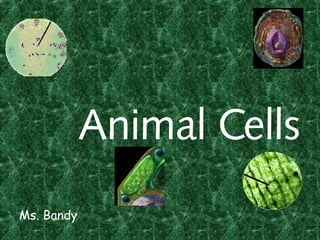
Animal cell pp lesson
- 2. Animal Cells Science Lesson Student will be able to: •identify the parts of a plant and animal cell •state the function of the cell parts •explain the differences between plant and animal cells •Organize cells
- 3. What are cells? What we know: What we want to know: What we learned:
- 5. Flashcards- Cell Unit Organism A living thing that is made up of cells. Cut out the words, pictures, and definitions Glue the words and pictures on the left side of the blank flashcard. Glue the definition on the right side. Cut out the flashcards, fold, and glue
- 6. Vocabulary Charades Divide into groups Each group will be assigned a vocabulary word. Each group will have 2 to 3 minutes to come up with how to act out their word without speaking. The class will play charades. Each group will take turns guessing the vocabulary word that is being acted out.
- 7. What are cells? What are cells? Cells are the smallest unit of living things that can carry out the basic processes of life. Where do cells come from? They come from other cells-Cells split or divided into two new cells- cells continually divide to make more cells for growth and repair. Mitosis- Mitosis describes the process by which the nucleus of a cell divides to create two new nuclei, each containing an identical copy of DNA. Meiosis- Meiosis, as described above, is the process by which certain sex cells are created. http://www.pbs.org/wgbh/nova/miracle/media/divi.swf
- 9. Organisms What do cells make when they come together? Organisms What are organisms? Organisms are living things. These organisms can range from microscopic to giant animals. What do organisms have in common? All living organisms are made up of cells.
- 10. Unicellular Organism Unicellular Organisms : Uni- meaning “one” base word “cell” ular- meaning “with one cell” A single cell that carries out its life processes. Growing, responding to an environment, reproducing, and getting food are its life processes. There are more than 1 billion kinds of unicellular organisms. Question: Why do you think there are more unicellular organisms than multicellular organisms?
- 11. Multicellular Organisms Multicellular Organisms : multus- means “many”; base word “cell”; ular- “with many cells” Organisms are made of more than one cell. Multicellular organisms include snakes, flowers, and you. Every cell carries out its own life process. The cells work together to take care of different functions for the organism. For example: heart cells will work to carry out the function to keep the heart beating; lung cells will carry out the function for breathing
- 12. Animal Cell All organisms are made up of cells. Our bodies alone have more than 200 different kinds of cells. For example: skin cells, heart cells, blood cells, etc. Animal Cells have basic structures that help the cell perform life process and keep the cell alive. These basic structures are called organelles. Main Organelles of an Animal Cell: Nucleus, cytoplasm, vacuole, mitochondria, cell membrane
- 13. Organelles and their jobs Cell Membrane The layer around the outside of the cell. It is the skin of the cell. It controls which substances enter and leave the cell. Cytoplasm A gel like liquid that occupies the region from the nucleus to the cell membrane. It supports all of the cell’s structures. Some of the cell’s life processes take place in the cytoplasm.
- 14. Organelles and their jobs Nucleus Round Cell’s control center Round organelle, found in the center of the cell It contains the master plans of all the cell’s activities. It sends signals to all the other parts of the cell. Functions controlled by the nucleus include: growth, movement, and dividing.
- 15. Organelles and their jobs Vacuoles It is used for storage. It can store water, food, or wastes. The nucleus signals a vacuole to release what it is storing. Some animal cells have many vacuoles or some have none.
- 16. Organelles and their jobs Mitochondria Oval Cells energy supply Tiny power plant It breaks down food and releases energy for the cell to use Cells that require a lot of energy will have a great many mitochondria. Muscle cells are an example. Questions to think about: 1. How is a mitochondrion similar to a tiny power plant? 2.Do you think a cell would function without a nucleus? Explain your answer.
- 17. Human Cell Activity Students will be assigned parts of the cell and take turns forming a cell.
- 18. Animal Cell
- 19. Make an Animal Cell Booklet Choose 7 pieces of paper Arrange them from least to greatest The least will be title page. Decorate how you want it The greatest will be page that the animal cell is drawn, labeled, and colored The between pages are for organelles. Draw organelle and list facts about the organelle. Title each page correctly. Look at example to check to see if titled correctly.
- 20. Let’s review: discuss these questions with a partner. 1. What is a cell? 2. What is a an organism? 3. Name the two types of organisms and their definitions. 4. How do cells divide? What are the two processes? 5. Name the five organelles. 6. Name the functions of the five organelles. 7. How is a tissue formed? Organ? Organ system?
- 21. Cell paragraph 1. You are a cell. You need to be a certain type of cell. 2. You are going to write a paragraph or paragraphs about what makes up a cell. 3. You will begin with what is a cell? 4. What do cells make up? 5. How are cells produced? 6. You are to describe the organelles and their functions. 7. You are to include the following vocabulary words in your paragraph(s): cell, organism, unicellular, multicellular, tissue, organ, organ system 8. Vocabulary words are to be used in the story and need to make sense.